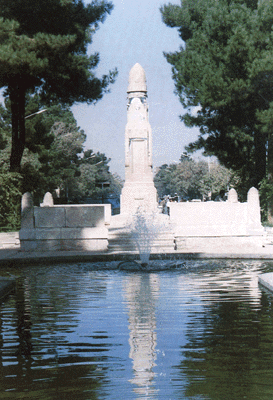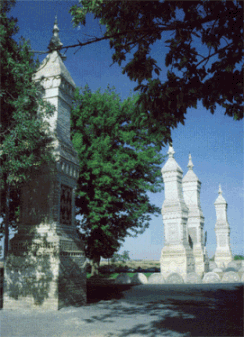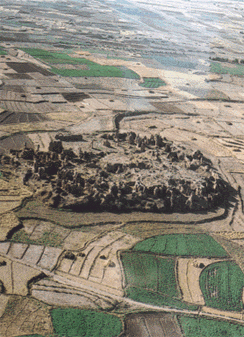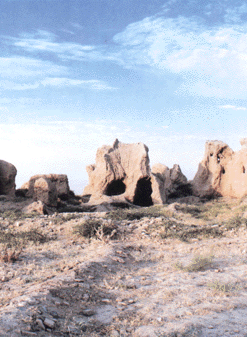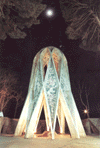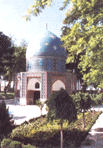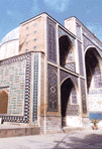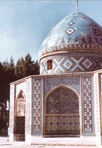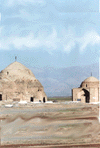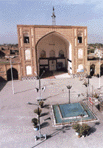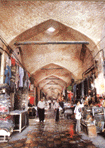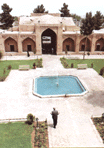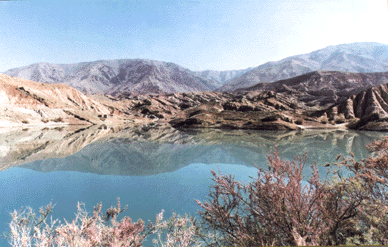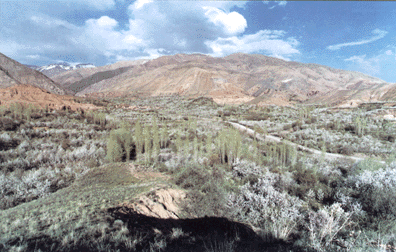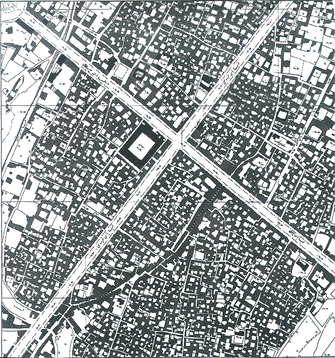Saturday, February 28, 2009
Neyshaboor
History
Nishapur occupies an important strategic position astride the old Silk Road that linked Anatolia and the Mediterranean with China. On the Silk Road, Nishapur has often defined the flexible frontier between the Iranian plateau and Central Asia. The town derived its name from its reputed founder, the Sassanian king Shapur I, who is said to have established it in the 3rd century CE. Nearby are the turquoise mines that supplied the world with turquoise for at least two millennia. It became an important town in the Khorasan region but subsequently declined in significance until a revival in its fortunes in 9th century under the Tahirid dynasty, when the glazed ceramics of Nishapur formed an important item of trade to the west. For a time Nishapur rivaled Baghdad or Cairo: Toghrül, the first ruler of the Seljuk dynasty, made Nishapur his residence in 1037 and proclaimed himself sultan there, but it declined thereafter, as Seljuk fortunes were concentrated in the west. In the year 1000CE, it was among the 10 largest cities on earth [2]. After the husband of Genghis Khan's daughter was killed at Nishapur in 1221, she ordered the death of all in the city (~1.7 million), and the skulls of men, women, and children were piled in pyramids by the Mongols. This invasion and earthquakes destroyed the pottery kilns. In 1979, the 15th World Scout Jamboree was scheduled to be held in Nishapur, but it was cancelled
Culture
Nishapur is also home to many poets and cultural celebrities. The poet Omar Khayyám was born in Nishapur in 1048 and is buried a few miles outside the town, near the Imamzadeh Mahroq Mosque. The 12th century poet and mystic Farid al-Din Attar, another native of Nishapur, is also buried nearby. And Iran's greatest contemporary painter, Kamal-ol-molk is buried in the same place. Also Nishapur has been the hometown of famous people including:
1. Muslim ibn al-Hajjaj (one of Islam's greatest muhaddiths, whose collection of hadith, Sahih Muslim, is second in authenticity only to Muhammad al-Bukhari's Sahih al-Bukhari)
2. Imam al-Hakim (another one of Islam's greatest muhaddiths and scholarly giants)
3. Prof. Mohammad Reza Shafiei-Kadkani (great contemporary Persian poet and writer and Persian literature Professor, who is famous for his literary criticism)
4. Ostad Parviz Meshkatian(famous Musician, researcher, Santur Player and composer).
5. Heydar Yaghma(an illiterate worker who began telling poems and published them.)
6. Hajji Bektash Wali(Muslim mystic, humanist and philosopher)
7. Wakil-i-Mutlaq , Burhan ul-Mulk, Itimad ud-Daula, Nawab Sayid Sa'adat Khan Bahadur, Shaukat Jang (Circa 1680-19 March 1739), better known as Saadat Khan or Burhan-ul-mulk, was the founder of the Awadh dynasty,UP, India.
Saadat Khan hailed from a noble Saiyid family from Nishapur in Khurasan. Born Mir Muhammad Amin, he entered the Mughal court as a camp superintendent but went on to obtain a mansab under Furrukhsiyar . He played an important role in the ascension of Muhammad Shah to the throne and overthrow of the Saiyid Brothers. He earned the title of Saadat Khan Bahadur in 1720 and was awarded the Governorship of Awadh as reward in 1722.
At the time, Lucknow was under the influence of a Muslim community, the Shaikhzadas. Saadat Khan settled the disturbed fortunes of his territory by military force, and established his court at Faizabad . He was summoned to Delhi by Nadir Shah , and died there in 1739.
Archaeology sites
Little archaeology has been done on this vast and complicated site. George Curzon remarked that Nishapur had been destroyed and rebuilt more times than any other city in history, an evocative statement whether or not it is statistically true. The Metropolitan Museum of Art undertook excavations from 1935 that were interrupted in 1940. Searching largely for museum-worthy trophies that they shared with the government of the Shah, the Metropolitan's publications were limited to its own Nishapur ceramics. The site of Nishapur has been ransacked for half a century since World War II, to feed the international market demand for early Islamic works of art.
Archaeology sites
Bowl with white slip, incised design, colored, and glazed. Excavated at Sabz Pushan, Neishapur. 9th-early 10th century. New York Metropolitan Museum of Art.
Little archaeology has been done on this vast and complicated site. George Curzon remarked that Nishapur had been destroyed and rebuilt more times than any other city in history, an evocative statement whether or not it is statistically true. The Metropolitan Museum of Art undertook excavations from 1935 that were interrupted in 1940. Searching largely for museum-worthy trophies that they shared with the government of the Shah, the Metropolitan's publications were limited to its own Nishapur ceramics. The site of Nishapur has been ransacked for half a century since World War II, to feed the international market demand for early Islamic works of art.
Recent incidents
* In the Summer of 1987(24.7.1987), a flood in Boojan village killed over 1,000 people and destroyed some villages.
* On February 18, 2004, in the Nishapur train disaster, a train carrying flammable goods derailed and caught fire near the town. Five hours later, during fire fighting and rescue work, a massive explosion destroyed the train and many nearby buildings. Around 300 people were said to have been killed, mainly fire and rescue workers but also the local governor and mayor and the heads of the fire and rail services.
Souvenirs
The most important Neyshabur souvenirs include turquoise and rhubarb.
Neyshabur Turquoise has been used for more than 2000 years and for this turquoise it is sometimes called "the turquoise land". Neyshabur turquoise and jewellery made from it are sold as souvenirs in Neyshabur and Mashhad resorts.
Rhubarb, a sour fruit, grows at the foot of Mount Binalud. Soft drinks made from this fruit, such as "Sharbate rivaas" (in Persian:شربت ریواس) and "Khoshaabe rivaas" (in Persian:خوشاب ریواس), are sold at some Neyshabur resorts as souvenirs.
Neyshaboor
Neyshaboor - A Glance on the Cultural,
Historical and Touristic Attractions
Located north of Khorosan, Nayshabur covers an area of 9.248 square kilometers. |
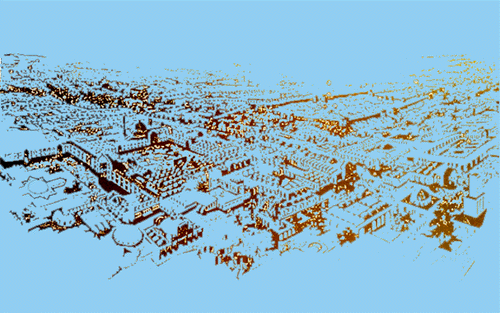 |
The History of Neyshaboor
| Located on the Silk-Road, Neyshaboor is one of the most ancient cities if Iran. It dates back to the Sassanid monarch, Shapur I. According to recent archaeological discoveries, Neyshaboor shared in trade with the valley of Indus river in Pakistan and the area of Mesopotamia in the 3rd millennium BC. Recently significant ancient sites, dating to the 3rd and 4th millennium BC, were discovered around the city. It seems that the most ancient evidence related to Neyshaboor is an inscription known as Ka´be-ye Zartosht (Ka´ba of Zoroaster). Dating in origin from the regin of Shapur I, it is also called Tamam Aparakhshtar. One of the most important pre-historical fire-temples, known as Azar-Barzin-Mehr, was located in Neyshaboor and dedicated to the farmers. It was formerly named Abarshahr, but from the Islamic period onwards its name changed into Neyshaboor. In the time of ´Abdollah ebn-e Taher, Neyshaboor served as a capitel and gradually grew in importance. After the fall of the Taherid dynasty, the Saffarids adopted it as a capitel. Under the Ghaznavids and Saffarids, It was brought to a peak and changed to the wealthiest and most populated Islamic areas. Soon after it razed to the ground, owing to the Mongol invasion. A new city was built on the north-western boundary of the old one shortly after, due to which the city flourished again. It was devastated by an earthquake in 808 AH. Neyshaboor rose to importance under the Timurid dynaty and grew in size and splendour, thanks to the efforts of the people who admire their culture and authorities who are conscious.
Remains of the ancient city of Neyshaboor Covering an area of about 2000 hectares, the remains of the ancient city of Neyshaboor is located on the south-eastern boundary of the present-day Neyshaboor. The area enjoys, ancient hills of Kohandezh, Alb-Arsalan, Sabz-pooshan, Shadiyakh, Tappeh Madraseh, Bazaar, Qanat Tappeh and Takestan. Its National Monuments Registration Number is 216.
Remains of the ancient city of Neyshaboor |
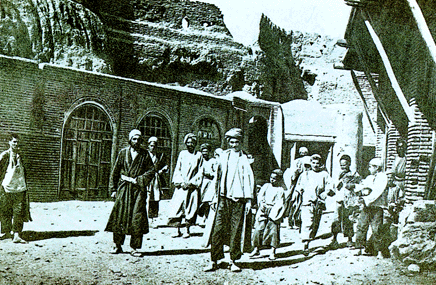
People in traditonal clothes in front of a city gate,
in the middle of the 19th century.
Iran
The 18th largest country in the world in terms of area at 1,648,195 km², Iran has a population of over seventy million. It is a country of special geostrategic significance due to its central location in Eurasia. Iran is bordered on the north by Armenia, Azerbaijan and Turkmenistan. As Iran is a littoral state of the Caspian Sea, which is an inland sea and condominium, Kazakhstan and Russia are also Iran's direct neighbors to the north. Iran is bordered on the east by Afghanistan and Pakistan, on the south by the Persian Gulf and the Gulf of Oman, and on the west by Turkey and Iraq. Tehran is the capital, the country's largest city and the political, cultural, commercial, and industrial center of the nation. Iran is a regional power, and occupies an important position in international energy security and world economy as a result of its large reserves of petroleum and natural gas.
Iran is home to one of the world's oldest continuous major civilizations, with historical and urban settlements dating back to 7000 BC.The first Iranian dynasty formed during the Elamite kingdom in 2800 BC. The Iranian Medes unified Iran into an empire in 625 BC.[2] They were succeeded by three Iranian Empires, the Achaemenids, Parthians and Sassanids, which governed Iran for more than 1000 years. Iranian post-Islamic dynasties and empires expanded the Persian language and culture throughout the Iranian plateau. Early Iranian dynasties which re-assereted Iranian independence included the Buyids, Samanids, Tahirids and Safarrids. The blossoming of Persian literature, philosophy, medicine, astronomy, mathematics and art became major elements of Muslim civilization and started with the Saffarids and Samanids. Iran was once again reunified as an independent state in 1501 by the Safavid dynasty—who promoted Twelver Shi'a Islam[18] as the official religion of their empire, marking one of the most important turning points in the history of Islam. "Persia's Constitutional Revolution" established the nation's first parliament in 1906, within a constitutional monarchy. Iran officially became an Islamic republic on 1 April 1979, after the Iranian 1979 Revolution.
Iran is a founding member of the UN, NAM, OIC and OPEC. The political system of Iran, based on the 1979 Constitution, comprises several intricately connected governing bodies. The highest state authority is the Supreme Leader. Shia Islam is the official religion and Persian is the official language.
Etymology
The term Iran (ایران) in modern Persian derives from the Proto-Iranian term Aryānā, first attested in Zoroastrianism's Avesta tradition. Ariya- and Airiia- are also attested as an ethnic designator in Achaemenid inscriptions. The term Ērān, from Middle Persian Ērān (written as ʼyrʼn) is found on the inscription that accompanies the investiture relief of Ardashir I at Naqsh-e Rustam.In this inscription, the king's appellation in Middle Persian contains the term ērān (Pahlavi ʼryʼn), while in the Parthian language inscription that accompanies it, the term aryān describes Iran. In Ardashir's time, ērān retained this meaning, denoting the people rather than the state.
Notwithstanding this inscriptional use of ērān to refer to the Iranian peoples, the use of ērān to refer to the geographical empire is also attested in the early Sassanid period. An inscription relating to Shapur I, Ardashir's son and immediate successor, includes regions which were not inhabited primarily by Iranians in Ērān regions, such as Armenia and the Caucasus."[25] In Kartir's inscriptions the high priest includes the same regions in his list of provinces of the antonymic Anērān. Both ērān and aryān come from the Proto-Iranian term Aryānām, (Land) of the (Iranian) Aryas. The word and concept of Airyanem Vaejah is present in the name of the country Iran (Lit. Land of the Aryans) inasmuch as Iran (Ērān) is the modern Persian form of the word Aryānā.
The country has always been known to its own people as Iran, however in the outside world, the official name of Iran from the 6th century BC until 1935 was Persia or similar foreign language translations (La Perse, Das Persien, Perzie, etc.). In that year, Reza Shah asked the international community to call the country by the name "Iran". A few years later, some Persian scholars protested to the government that changing the name had separated the country from its past, so in 1949 Mohammad Reza Shah announced that both terms could officially be used interchangeably. Now both terms are common, but "Iran" is used mostly in the modern political context and "Persia" in a cultural and historical context. Since the Iranian Revolution of 1979, the official name of the country has been the "Islamic Republic of Iran."
Geography and climate

Iran is the eighteenth largest country in the world.[26] Its area roughly equals that of the United Kingdom, France, Spain, and Germany combined, or slightly less than the state of Alaska.Its borders are with Azerbaijan (432 km/268 mi) and Armenia (35 km/22 mi) to the north-west; the Caspian Sea to the north; Turkmenistan (992 km/616 mi) to the north-east; Pakistan (909 km/565 mi) and Afghanistan (936 km/582 mi) to the east; Turkey (499 km/310 mi) and Iraq (1,458 km/906 mi) to the west; and finally the waters of the Persian Gulf and the Gulf of Oman to the south. Iran's area is 1,648,000 km² (approximately 636,300 sq mi).[29]
Eurasian Lynx
Iran consists of the Iranian Plateau with the exception of the coasts of the Caspian Sea and Khuzestan. It is one of the world's most mountainous countries, its landscape dominated by rugged mountain ranges that separate various basins or plateaux from one another. The populous western part is the most mountainous, with ranges such as the Caucasus, Zagros and Alborz Mountains; the latter contains Iran's highest point, Mount Damavand at 5,610 m (18,405 ft), which is not only the country's highest peak but also the highest mountain on the Eurasian landmass west of the Hindu Kush.[30] The Northern part of Iran is covered by dense rain forests called Shomal or the Jungles of Iran. The eastern part consists mostly of desert basins such as the Dasht-e Kavir, Iran's largest desert, in the north-central portion of the country, and the Dasht-e Lut, in the east, as well as some salt lakes. This is because the mountain ranges are too high for rain clouds to reach these regions. The only large plains are found along the coast of the Caspian Sea and at the northern end of the Persian Gulf, where Iran borders the mouth of the Shatt al-Arab (or the Arvand Rūd) river. Smaller, discontinuous plains are found along the remaining coast of the Persian Gulf, the Strait of Hormuz and the Sea of Oman.
Iran's climate ranges from arid or semiarid, to subtropical along the Caspian coast and the northern forests. On the northern edge of the country (the Caspian coastal plain) temperatures nearly fall below freezing and it remains humid for the rest of the year. Summer temperatures rarely exceed 29 °C (85 °F).[31][32] Annual precipitation is 680 mm (27 in) in the eastern part of the plain and more than 1,700 mm (67 in) in the western part. To the west, settlements in the Zagros basin experience lower temperatures, severe winters with below zero average daily temperatures and heavy snowfall. The eastern and central basins are arid, with less than 200 mm (eight in) of rain, and have occasional deserts.Average summer temperatures exceed 38 °C (100 °F). The coastal plains of the Persian Gulf and Gulf of Oman in southern Iran have mild winters, and very humid and hot summers. The annual precipitation ranges from 135 to 355 mm (five to fourteen inches).
Iran's wildlife is composed of several animal species including bears, gazelles, wild pigs, wolves, jackals, panthers, Eurasian lynx, and foxes. Other domestic animals include, sheep, goats, cattle, horses, water buffalo, donkeys, and camels. The pheasant, partridge, stork, eagles and falcon are also native to Iran.
Provinces and cities

Iran is divided into thirty provinces (ostān), each governed by an appointed governor (استاندار, ostāndār). The provinces are divided into counties (shahrestān), and subdivided into districts (bakhsh) and sub-districts (dehestān).
Iran has one of the highest urban growth rates in the world. From 1950 to 2002, the urban proportion of the population increased from 27% to 60%. The United Nations predicts that by 2030 80% of the population will be urban. Most internal migrants have settled near the cities of Tehran, Isfahan, Ahvaz, and Qom. The listed populations are from the 2006/07 (1385 AP) census.Tehran, with population of 7,705,036, is the largest city in Iran and is the Capital city. Tehran is home to around 11% of Iran's population. Tehran, like many big cities, suffers from severe air pollution. It is the hub of the country's communication and transport network.
Mashhad, with a population of 2.8 million, is the second largest Iranian city and the centre of the province of Razavi Khorasan. Mashahd is one of the holiest Shi'a cities in the world as it is the site of the Imam Reza shrine. It is the centre of tourism in Iran and between 15 and 20 million pilgrims go to the Imam Reza's shrine every year. Another major Iranian city is Isfahan (population 1,986,542), which is the capital of Isfahan Province. The Naghsh-e Jahan Square in Isfahan has been designated by UNESCO as a World Heritage Site. The city contains a wide variety of Islamic architectural sites ranging from the eleventh to the 19th century. The growth of suburb area around the city has turned Isfahan to the second most populous metropolitan area (3,430,353). The other major Iranian cities are Karaj (population 1,732,275), Tabriz (population 1,597,312) and Shiraz (population 1,227,331). Karaj is located in Tehran province and is situated 20 km west of Tehran, at the foot of Alborz mountains; however, the city is increasingly becoming an extension of metropolitan Tehran.
History
Main articles: History of Iran and Persian Empire
Early history (3200 BC–625 BC)
Dozens of pre-historic sites across the Iranian plateau point to the existence of ancient cultures and urban settlements in the fourth millennium BC,centuries before the earliest civilizations arose in nearby Mesopotamia.Proto-Iranians first emerged following the separation of Indo-Iranians, and are traced to the Bactria-Margiana Archaeological Complex. Aryan, (Proto-Iranian) tribes arrived in the Iranian plateau in the third and second millennium BC, probably in more than one wave of emigration, and settled as nomads. Further separation of Proto-Iranians into "Eastern" and "Western" groups occurred due to migration. By the first millennium BC, Medes, Persians, Bactrians and Parthians populated the western part, while Cimmerians, Sarmatians and Alans populated the steppes north of the Black Sea. Other tribes began to settle on the eastern edge, as far as on the mountainous frontier of north-western Indian subcontinent and into the area which is now Balochistan. Others, such as the Scythian tribes spread as far west as the Balkans and as far east as Xinjiang. Avestan is an eastern Old Iranian language that was used to compose the sacred hymns and canon of the Zoroastrian Gathas in c. 1000 BC.
Pre-Islamic statehood (625 BC–651 AD)

The Medes are credited with the unification[2] of Iran as a nation and empire (625[2]–559 BC), the largest of its day, until Cyrus the Great established a unified empire of the Medes and Persians leading to the Achaemenid Empire (559–330 BC), and further unification between peoples and cultures. After Cyrus' death, his son Cambyses continued his father's work of conquest, making significant gains in Egypt. Following a power struggle after Cambyses' death, Darius I was declared king (ruled 522–486 BC). Under Cyrus the Great and Darius the Great, the Persian Empire eventually became the largest and most powerful empire in human history up until that point. The borders of the Persian empire stretched from the Indus and Oxus Rivers in the east to the Mediterranean Sea in the west, extending through Anatolia (modern day Turkey) and Egypt.
The Achaemenid Empire at its greatest extent, at about 500 BC
In 499 BC Athens lent support to a revolt in Miletus which resulted in the sacking of Sardis. This led to an Achaemenid campaign against Greece known as the Greco-Persian Wars which lasted the first half of the 5th century BC. During the Greco-Persian wars Persia made some major advantages and razed Athens in 480 BC, But after a string of Greek victories the Persians were forced to withdraw. Fighting ended with the peace of Callias in 449 BC.
Persepolis, ceremonial capital of the Persian Empire during the Achaemenid dynasty
The rules and ethics emanating from Zoroaster's teachings were strictly followed by the Achaemenids who introduced and adopted policies based on human rights, equality and banning of slavery. Zoroastrianism spread unimposed during the time of the Achaemenids and through contacts with the exiled Jewish people in Babylon freed by Cyrus, Zoroastrian concepts further propagated and influenced into other Abrahamic religions. The Golden Age of Athens marked by Aristotle, Plato and Socrates also came about during the Achaemenid period while their contacts with Persia and the Near East abounded. The peace, tranquility, security and prosperity that were afforded to the people of the Near East and Southeastern Europe proved to be a rare historical occurrence, an unparalleled period where commerce prospered, and the standard of living for all people of the region improved.
In 334 BC, Alexander the Great invaded the Achaemenid Empire, defeating the last Achaemenid Emperor Darius III at the Battle of Issus in 333 BC. He left the annexed territory in 328–327. In each of the former Achaemenid territories he installed his own officers as caretakers, which led to friction and ultimately to the partitioning of the former empire after Alexander's death.
A bust from the National Museum of Iran of Queen Musa
The Parthian Empire (238 BC–226 AD), led by the Arsacid Dynasty, was the third Iranian kingdom to dominate the Iranian plateau, after defeating the Greek Seleucid Empire, beginning in the late 3rd century BC, and intermittently controlled Mesopotamia between ca. 150 BC and 224 AD. These were the third native dynasty of ancient Iran and lasted five centuries. After the conquests of Media, Assyria, Babylonia and Elam, the Parthians had to organize their empire. The former elites of these countries were Greek, and the new rulers had to adapt to their customs if they wanted their rule to last. As a result, the cities retained their ancient rights and civil administrations remained more or less undisturbed.
Parthia was the arch-enemy of the Roman Empire in the east, limiting Rome's expansion beyond Cappadocia (central Anatolia). By using a heavily armed and armoured cataphract cavalry, and lightly armed but highly mobile mounted archers, the Parthians "held their own against Rome for almost 300 years".[46] Rome's acclaimed general Mark Antony led a disastrous campaign against the Parthians in 36 BC, in which he lost 32,000 men. By the time of Roman emperor Augustus, Rome and Parthia were settling some of their differences through diplomacy. By this time, Parthia had acquired an assortment of golden eagles, the cherished standards of Rome's legions, captured from Mark Antony, and Crassus, who suffered a defeat at Carrhae in 53 BC.
Rock-face relief at Naqsh-e Rustam of Iranian emperor Shapur I (on horseback) capturing Roman emperor Valerian (kneeing) and Philip the Arab (standing)
The end of the Parthian Empire came in 224 AD, when the empire was loosely organized and the last king was defeated by Ardashir I, one of the empire's vassals. Ardashir I then went on to create the Sassanid Empire. Soon he started reforming the country both economically and militarily. The Sassanids established an empire roughly within the frontiers achieved by the Achaemenids, referring to it as Erânshahr or Iranshahr, , "Dominion of the Aryans", (i.e. of Iranians), with their capital at Ctesiphon.[48] Unlike the diadochic Seleucids and the succeeding Arsacids, who used a vassalary system, the Sassanids—like the Achaemenids—had a system of governors (MP: shahrab) personally appointed by the Emperor and directed by the central government. The Romans suffered repeated losses particularly by Ardashir I, Shapur I, and Shapur II.[49] During their reign, Sassanid battles with the Roman Empire caused such pessimism in Rome that the historian Cassius Dio wrote:
“ Here was a source of great fear to us. So formidable does the Sassanid king seem to our eastern legions, that some are liable to go over to him, and others are unwilling to fight at all.[50] ”
In 632 raiders from the Arab peninsula began attacking the Sassanid Empire. Iran was defeated in the Battle of al-Qâdisiyah, paving way for the Islamic conquest of Persia.
During Parthian, and later Sassanid era, trade on the Silk Road was a significant factor in the development of the great civilizations of China, Egypt, Mesopotamia, Persia, Indian subcontinent, and Rome, and helped to lay the foundations for the modern world. Parthian remains display classically Greek influences in some instances and retain their oriental mode in others, a clear expression of the cultural diversity that characterized Parthian art and life.The Parthians were innovators of many architecture designs such as that of Ctesiphon, which later influenced European Romanesque architecture.Under the Sassanids, Iran expanded relations with China. Arts, music, and architecture greatly flourished, and centers such as the School of Nisibis and Academy of Gundishapur became world renowned centers of science and scholarship.
Middle Ages (652–1501)
Iranians continued what was set-up by Sassanids but in much larger scale and with a more universal scope. Therefore blossoming of Persian literature, philosophy, medicine and art became major elements of the newly forming Muslim civilization. The Islamic Golden Age which is characterized by the development of science owed, to a large extent, its importance to the vital contributions of Iranians, and reached its highest level in 10-11th centuries a period in which Persia was the main theatre of scientific activities.[54] In fact this influential Persian presence that relied heavily upon achievements of Sassanids whose identity and continuity had to be assumed by the educated, has made the Muslim world itself long since come to accept Islamic civilization as a Perso-Islamic civilization and had the latter as the continuous uprising culture from eleventh century on.Even in developing the scientific Arabic prose itself which differs in style from that of Quran, Persian scholars like Ibn al-Muqaffa had a major role. And the whole class of clerks and civil administrators which was so responsible for the cultivation of the sciences in the early Islamic centuries consisted mostly of Persians.[57] The contributions of Iranians in Arabic language is however not limited to scientific prose needed by themselves, but also in Arabic poetry. These contributions by Iranians are characterised as "the lively and graceful fancy, elegance of diction, depth and tenderness of feeling and a rich store of ideas"
Abu Moslem, an Iranian general, expelled the Umayyads from Damascus and helped the Abbasid caliphs to conquer Baghdad. The Abbasid caliphs frequently chose their "wazirs" (viziers) among Iranians, and Iranian governors acquired a certain amount of local autonomy. Thus in 822, the governor of Khorasan, Tahir, proclaimed his independence and founded a new Persian dynasty of Tahirids. And by the Samanid era, Iran's efforts to regain its independence had been well solidified.
Illustration from Jami "Rose Garden of the Pious", dated 1553. The image blends Persian poetry and Persian miniature into one, as is the norm for many works of the Timurid era.
Attempts of Arabization thus never succeeded in Iran, and movements such as the Shuubiyah became catalysts for Iranians to regain their independence in their relations with the Arab invaders. The cultural revival of the post-Abbasid period led to a resurfacing of Iranian national identity. The resulting cultural movement reached its peak during the 9th and 10th centuries. The most notable effect of the movement was the continuation of the Persian language, the language of the Persians and the official language of Iran to the present day. Ferdowsi, Iran's greatest epic poet, is regarded today as the most important figure in maintaining the Persian language. After an interval of silence Iran re-emerged as a separate, different and distinctive element within Islam. Iranian philosophy after the Islamic conquest, is characterized by different interactions with the Old Iranian philosophy, the Greek philosophy and with the development of Islamic philosophy. The Illumination School and the Transcendent Philosophy are regarded as two of the main philosophical traditions of that era in Persia. The movement continued well into the 11th century, when Mahmud-a Ghaznavi founded a vast empire, with its capital at Isfahan and Ghazna. Their successors, the Seljuks, asserted their domination from the Mediterranean Sea to Central Asia. As with their predecessors, the divan of the empire was in the hands of Iranian viziers, who founded the Nizamiyya. During this period, hundreds of scholars and scientists vastly contributed to technology, science and medicine, later influencing the rise of European science during the Renaissance.
In 1218, the eastern Khwarazmid provinces of Transoxiana and Khorasan suffered a devastating invasion by Genghis Khan. During this period more than half of Iran's population was killed,turning the streets of Persian cities such as Neishabur into "rivers of blood", as the severed heads of men, women, and children were "neatly stacked into carefully constructed pyramids around which the carcasses of the city's dogs and cats were placed". Between 1220 and 1260, the total population of Iran had dropped from 2,500,000 to 250,000 as a result of mass extermination and famine. In a letter to King Louis IX of France, Holaku, one of the Genghis Khan's grandsons, alone took responsibility for 200,000 deaths in his raids of Iran and the Caliphate. He was followed by yet another conqueror, Tamerlane, who established his capital in Samarkand. The waves of devastation prevented many cities such as Neishabur from reaching their pre-invasion population levels until the 20th century, eight centuries later.[66] But both Hulagu, Tamerlane, and their successors soon came to adopt the ways and customs of that which they had conquered, choosing to surround themselves with a culture that was distinctively Persian.
Early Modern Era (1501–1921)
Iran's first encompassing Shi'a Islamic state was established under the Safavid Dynasty (1501–1722) by Shah Ismail I. The Safavid Dynasty soon became a major political power and promoted the flow of bilateral state contacts. The Safavid peak was during the rule of Shah Abbas The Great.[19] The Safavid Dynasty frequently warred with the Ottoman Empire, Uzbek tribes and the Portuguese Empire. The Safavids moved their capital from Tabriz to Qazvin and then to Isfahan, where their patronage for the arts propelled Iran into one of its most aesthetically productive eras. Under their rule, the state became highly centralized, the first attempts to modernize the military were made, and even a distinct style of architecture developed. In 1722 Afghan rebels defeated Shah Sultan Hossein and ended the Safavid Dynasty, but in 1735, Nader Shah successfully drove out the Afghan rebels from Isfahan and established the Afsharid Dynasty. He then staged an incursion into India in 1738, securing the Peacock throne, Koh-i-Noor, and Darya-ye Noor among other royal treasures. His rule did not last long, however, as he was assassinated in 1747. The Mashhad based Afshar Dynasty was succeeded by the Zand dynasty in 1750, founded by Karim Khan, who established his capital at Shiraz. His rule brought a period of relative peace and renewed prosperity.
The Zand dynasty lasted three generations, until Aga Muhammad Khan executed Lotf Ali Khan, and founded his new capital in Tehran, marking the dawn of the Qajar Dynasty in 1794. The Qajar chancellor Amir Kabir established Iran's first modern college system, among other modernizing reforms. Iran suffered several wars with Imperial Russia during the Qajar era, resulting in Iran losing almost half of its territories to Imperial Russia and the British Empire, via the treaties of Gulistan, Turkmenchay and Akhal. In spite of The Great Game Iran managed to maintain her sovereignty and was never colonized, unlike neighbouring states in the region. Repeated foreign intervention and a corrupt and weakened Qajar rule led to various protests, which by the end of the Qajar period resulted in Persia's constitutional revolution establishing the nation's first parliament in 1906, within a constitutional monarchy.
Recent history (1921–)
In 1925, Reza Khan overthrew the weakening Qajar Dynasty and became Shah. Reza Shah initiated industrialization, railroad construction, and the establishment of a national education system. Reza Shah sought to balance Russian and British influence, but when World War II started, his nascent ties to Germany alarmed Britain and Russia. In 1941, Britain and the USSR invaded Iran to use Iranian railroad capacity during World War II. The Shah was forced to abdicate in favour of his son, Mohammad Reza Pahlavi.
Mohammad Reza Pahlavi and Queen Farah about to depart after a visit to the United States
In 1951 Dr. Mohammed Mossadegh was elected prime minister. As prime minister, Mossadegh became enormously popular in Iran after he nationalized Iran's oil reserves. In response, Britain embargoed Iranian oil and, amidst Cold War fears, invited the United States to join in a plot to depose Mossadegh, and in 1953 President Dwight D. Eisenhower authorized Operation Ajax. The operation was successful, and Mossadegh was arrested on 19 August 1953. After Operation Ajax, Mohammad Reza Pahlavi's rule became increasingly autocratic. With American support, the Shah was able to rapidly modernize Iranian infrastructure, but he simultaneously crushed all forms of political opposition with his intelligence agency, SAVAK. Ayatollah Ruhollah Khomeini became an active critic of the Shah's White Revolution and publicly denounced the government. Khomeini was arrested and imprisoned for 18 months. After his release in 1964 Khomeini publicly criticized the United States government. The Shah was persuaded to send him into exile by General Hassan Pakravan. Khomeini was sent first to Turkey, then to Iraq and finally to France. While in exile, he continued to denounce the Shah.
The Iranian Revolution, also known as the Islamic Revolution,[68][69][70] began in January 1978 with the first major demonstrations against the Shah.[71] After strikes and demonstrations paralysed the country and its economy, the Shah fled the country in January 1979 and Ayatollah Khomeini returned from exile to Tehran. The Pahlavi Dynasty collapsed ten days later, on 11 February, when Iran's military declared itself "neutral" after guerrillas and rebel troops overwhelmed troops loyal to the Shah in armed street fighting. Iran officially became an Islamic Republic on 1 April 1979 when Iranians overwhelmingly approved a national referendum to make it so.[20][21] In December 1979, the country approved a theocratic constitution, whereby Khomeini became Supreme Leader of the country. The speed and success of the revolution surprised many throughout the world, as it had not been precipitated by a military defeat, a financial crisis, or a peasant rebellion. Although both nationalists and Marxists joined with Islamic traditionalists to overthrow the Shah, tens of thousands were killed and executed by the Islamic regime afterward, the revolution ultimately resulted in an Islamic Republic under Ayatollah Ruhollah Khomeini.
Arrival of Ayatollah Khomeini on 1 February 1979 from France
Iran's relationship with the United States deteriorated rapidly during the revolution. On 4 November 1979, a group of Iranian students seized US embassy personnel, labelling the embassy a "den of spies". They accused its personnel of being CIA agents plotting to overthrow the revolutionary government, as the CIA had done to Mohammad Mossadegh in 1953. While the student ringleaders had not asked for permission from Khomeini to seize the embassy, Khomeini nonetheless supported the embassy takeover after hearing of its success.[76] While most of the female and African American hostages were released within the first months,[76] the remaining fifty-two hostages were held for 444 days. Subsequently attempts by the Jimmy Carter administration to negotiate or rescue were unsuccessful. In January 1981 the hostages were set free according to the Algiers declaration.
Iraqi leader Saddam Hussein decided to take advantage of what he perceived to be disorder in the wake of the Iranian Revolution and its unpopularity with Western governments. The once-strong Iranian military had been disbanded during the revolution. Saddam sought to expand Iraq's access to the Persian Gulf by acquiring territories that Iraq had claimed earlier from Iran during the Shah's rule. Of chief importance to Iraq was Khuzestan which not only has a substantial Arab population, but boasted rich oil fields as well. On the unilateral behalf of the United Arab Emirates, the islands of Abu Musa and the Greater and Lesser Tunbs became objectives as well. On 22 September 1980 the Iraqi army invaded Iran at Khuzestan, precipitating the Iran–Iraq War.
Although Saddam Hussein's forces made several early advances, by 1982, Iranian forces managed to push the Iraqi army back into Iraq. Khomeini sought to export his Islamic revolution westward into Iraq, especially on the majority Shi'a Arabs living in the country. The war then continued for six more years until 1988, when Khomeini, in his words, "drank the cup of poison" and accepted a truce mediated by the United Nations. The total Iranian casualties of the war were estimated to be anywhere between 500,000 and 1,000,000; with more than 100,000 Iranians being victims of Iraq's chemical weapons.[77] Almost all relevant international agencies have confirmed that Saddam engaged in chemical warfare to blunt Iranian human wave attacks; these agencies unanimously confirmed that Iran never used chemical weapons during the war.
Following the Iran–Iraq War President Akbar Hashemi Rafsanjani and his administration concentrated on a pragmatic pro-business policy of rebuilding and strengthening the economy without making any dramatic break with the ideology of the revolution. Rafsanjani served until 1997 when he was succeeded by the moderate reformist Mohammad Khatami. During his two terms as president, Khatami advocated freedom of expression, tolerance and civil society, constructive diplomatic relations with other states including EU and Asian governments, and an economic policy that supported free market and foreign investment. However, Khatami is widely regarded as having been unsuccessful in achieving his goal of making Iran more free and democratic. In the 2005 presidential elections, Iran made yet another change in political direction, when conservative populist candidate Mahmoud Ahmadinejad was elected over Akbar Hashemi Rafsanjani.
Government and politics
Main articles: Politics and Government of Iran, Supreme Leader of Iran, President of Iran, Majlis of Iran, Council of Guardians, Expediency Discernment Council, Judicial system of Iran, Assembly of Experts, and City and Village Councils of Iran
Current government structure in Iran
The political system of the Islamic Republic is based on the 1979 Constitution. The system comprises several intricately connected governing bodies. The Supreme Leader of Iran is responsible for delineation and supervision of the general policies of the Islamic Republic of Iran.The Supreme Leader is Commander-in-Chief of the armed forces, controls the military intelligence and security operations; and has sole power to declare war or peace.[83] The heads of the judiciary, state radio and television networks, the commanders of the police and military forces and six of the twelve members of the Council of Guardians are appointed by the Supreme Leader.The Assembly of Experts elects and dismisses the Supreme Leader on the basis of qualifications and popular esteem. The Assembly of Experts is responsible for supervising the Supreme Leader in the performance of legal duties.
After the Supreme Leader, the Constitution defines the President of Iran as the highest state authority.The President is elected by universal suffrage for a term of four years and can only be re-elected for one term.Presidential candidates must be approved by the Council of Guardians prior to running in order to ensure their allegiance to the ideals of the Islamic revolution.The President is responsible for the implementation of the Constitution and for the exercise of executive powers, except for matters directly related to the Supreme Leader, who has the final say in all matters. The President appoints and supervises the Council of Ministers, coordinates government decisions, and selects government policies to be placed before the legislature.Eight Vice-Presidents serve under the President, as well as a cabinet of twenty two ministers, who must all be approved by the legislature. Unlike many other states, the executive branch in Iran does not control the armed forces. Although the President appoints the Ministers of Intelligence and Defense, it is customary for the President to obtain explicit approval from the Supreme Leader for these two ministers before presenting them to the legislature for a vote of confidence. Iran's current president, Mahmoud Ahmadinejad, was elected in a run-off poll in the 2005 presidential elections. His term expires in 2009.
Ali Khamenei, Supreme Leader of Iran
As of 2008, the Legislature of Iran (also known as the Majlis of Iran) is a unicameral body.Before the Iranian Revolution, the legislature was bicameral, but the upper house was removed under the new constitution. The Majlis of Iran comprises 290 members elected for four-year terms.The Majlis drafts legislation, ratifies international treaties, and approves the national budget. All Majlis candidates and all legislation from the assembly must be approved by the Council of Guardians. The Council of Guardians comprises twelve jurists including six appointed by the Supreme Leader. The others are elected by the Parliament from among the jurists nominated by the Head of the Judiciary. The Council interprets the constitution and may veto Parliament. If a law is deemed incompatible with the constitution or Sharia (Islamic law), it is referred back to Parliament for revision. In a controversial exercise of its authority, the Council has drawn upon a narrow interpretation of Iran's constitution to veto parliamentary candidates. The Expediency Council has the authority to mediate disputes between Parliament and the Council of Guardians, and serves as an advisory body to the Supreme Leader, making it one of the most powerful governing bodies in the country.
Shirin Ebadi, human rights activist who won 2003 Nobel Peace Prize
The Supreme Leader appoints the head of Iran's Judiciary, who in turn appoints the head of the Supreme Court and the chief public prosecutor.[94] There are several types of courts including public courts that deal with civil and criminal cases, and "revolutionary courts" which deal with certain categories of offenses, including crimes against national security. The decisions of the revolutionary courts are final and cannot be appealed.[94] The Special Clerical Court handles crimes allegedly committed by clerics, although it has also taken on cases involving lay people. The Special Clerical Court functions independently of the regular judicial framework and is accountable only to the Supreme Leader. The Court's rulings are final and cannot be appealed.
The Assembly of Experts, which meets for one week annually, comprises 86 "virtuous and learned" clerics elected by adult suffrage for eight-year terms. As with the presidential and parliamentary elections, the Council of Guardians determines candidates' eligibility.[94] The Assembly elects the Supreme Leader and has the constitutional authority to remove the Supreme Leader from power at any time.[94] As all of their meetings and notes are strictly confidential, the Assembly has never been publicly known to challenge any of the Supreme Leader's decisions.
Local City Councils are elected by public vote to four-year terms in all cities and villages of Iran. According to article seven of Iran's Constitution, these local councils together with the Parliament are "decision-making and administrative organs of the State". This section of the constitution was not implemented until 1999 when the first local council elections were held across the country. Councils have many different responsibilities including electing mayors, supervising the activities of municipalities; studying, planning, co-ordinating and implementing of social, cultural, educational, health, economic, and welfare requirements of their constituencies.
Foreign relations and military
Iran's foreign relations are based on two strategic principles: eliminating outside influences in the region and pursuing extensive diplomatic contacts with developing and non-aligned countries. Iran maintains diplomatic relations with almost every member of the United Nations, except for Israel, which Iran does not recognize, and the United States since the Iranian Revolution.[95] Since 2005, Iran's Nuclear Program has become the subject of contention with the West because of suspicions regarding Iran's military intentions. This has led the UN Security Council to impose sanctions against Iran on select companies linked to this program, thus furthering its economic isolation on the international scene.
The Islamic Republic of Iran has two types of armed forces: the regular forces Islamic Republic of Iran Army, Islamic Republic of Iran Air Force, Islamic Republic of Iran Navy and the Islamic Revolutionary Guards Corps (IRGC), totalling about 545,000 active troops. Iran also has around 350,000 Reserve Force totaling around 900,000 trained troops.Iran has not invaded any country over the past two centuries.[97] Iran has a paramilitary, volunteer militia force within the IRGC, called the Basij, which includes about 90,000 full-time, active-duty uniformed members. Up to 11 million men and women are members of the Basij who could potentially be called up for service; GlobalSecurity.org estimates Iran could mobilize "up to one million men". This would be among the largest troop mobilizations in the world. In 2005, Iran's military spending represented 3.3% of the GDP or $91 per capita, the lowest figure of the Persian Gulf nations.Iran's military doctrine is based on deterrence.
Since the Iranian revolution, to overcome foreign embargo, Iran has developed its own military industry, produced its own tanks, armored personnel carriers, guided missiles, submarines, and fighter planes.[101] In recent years, official announcements have highlighted the development of weapons such as the Hoot, Kowsar, Zelzal, Fateh-110, Shahab-3 and Sajjil missiles, and a variety of unmanned aerial vehicles (UAVs).[ The Fajr-3 (MIRV) is currently Iran's most advanced ballistic missile, it is a liquid fuel missile with an undisclosed range which was developed and produced domestically.
Economy
Iran's economy is a mixture of central planning, state ownership of oil and other large enterprises, village agriculture, and small-scale private trading and service ventures.[103] Its economic infrastructure has been improving steadily over the past two decades but continues to be affected by inflation and unemployment.In the early 21st century the service sector contributed the largest percentage of the GDP, followed by industry (mining and manufacturing) and agriculture. In 2006, about 45% of the government's budget came from oil and natural gas revenues, and 31% came from taxes and fees.[105] Government spending contributed to an average annual inflation rate of 14% in the period 2000–2004. Iran has earned $70 billion in foreign exchange reserves mostly from crude oil exports (80% as of 2007).[106] In 2007, the GDP was estimated at $206 billion ($852 billion at PPP), or $3,160 per capita ($12,300 at PPP). Iran's official annual growth rate was at 6% (2008). Because of these figures and the country’s diversified but small industrial base, the United Nations classifies Iran's economy as semi-developed.
Tehran was one of the first cities in Iran which was modernized in the Pahlavi era
Close to 1.8% of national employment is generated in the tourism sector which is slated to increase to 10% in the next five years. About 1,659,000 foreign tourists visited Iran in 2004; most came from Asian countries, including the republics of Central Asia, while a small share came from the countries of the European Union and North America. Iran currently ranks 89th in tourist income, but is rated among the 10 most touristic countries in the world.[110] Weak advertising, unstable regional conditions, a poor public image in some parts of the world, and absence of efficient planning schemes in the tourism sector have all hindered the growth of tourism.
The administration continues to follow the market reform plans of the previous one and indicated that it will diversify Iran's oil-reliant economy. Iran has also developed a biotechnology, nanotechnology, and pharmaceuticals industry. The strong oil market since 1996 helped ease financial pressures on Iran and allowed for Tehran's timely debt service payments. Iranian budget deficits have been a chronic problem, mostly due to large-scale state subsidies, that include foodstuffs and especially gasoline, totaling more than $84 billion in 2008 for the energy sector alone.
The authorities so as the private sector have put in the past 15 years an emphasis on the local production of domestic-consumption oriented goods such as home appliances, cars, agricultural products, pharmaceutical, etc. Today, Iran possesses a good manufacturing industry, despite restrictions imposed by foreign countries. However, nationalized industries such as the bonyads have often been managed badly, making them ineffective and uncompetitive with years. Currently, the government is trying to privatize these industries, and, despite successes, there are still several problems to be overcome, such as the lagging corruption in the public sector (and, therefore, nationalized industries) and lack of competitiveness.
Globally, Iran has leading manufacture industry in the fields of car-manufacture and transportations, construction materials, home appliances, food and agricultural goods, armaments, pharmaceuticals, information technology, power and petrochemicals.
Energy
Iran ranks second in the world in natural gas reserves and also second in oil reserves.[115] It is OPEC's 2nd largest oil exporter. In 2005, Iran spent $4 billion on fuel imports, because of contraband and inefficient domestic use.[116] Oil industry output averaged 4 million barrels per day (640,000 m³/d) in 2005, compared with the peak of six million barrels per day reached in 1974. In the early 2000s, industry infrastructure was increasingly inefficient because of technological lags. Few exploratory wells were drilled in 2005.
In 2004, a large share of Iran's natural gas reserves were untapped. The addition of new hydroelectric stations and the streamlining of conventional coal and oil-fired stations increased installed capacity to 33,000 megawatts. Of that amount, about 75% was based on natural gas, 18% on oil, and 7% on hydroelectric power. In 2004, Iran opened its first wind-powered and geothermal plants, and the first solar thermal plant is to come online in 2009. Demographic trends and intensified industrialization have caused electric power demand to grow by 8% per year. The government’s goal of 53,000 megawatts of installed capacity by 2010 is to be reached by bringing on line new gas-fired plants and by adding hydroelectric, and nuclear power generating capacity. Iran’s first nuclear power plant at Bushehr is set to go online by mid-2009.
Demography
Iran is a diverse country consisting of people of many religions and ethnic backgrounds cemented by the Persian culture. The majority of the population speaks the Persian language, which is also the official language of the country, as well as other Iranian languages or dialects. Turkic languages and dialects (most importantly Azeri) are spoken in different areas in Iran. Additionally, Arabic is spoken in the southwestern parts of the country.
The main ethnic groups are Persians (51%), Azeris (24%), Gilaki and Mazandarani (8%), Kurds (7%), Arabs (3%), Baluchi (2%), Lurs (2%), Turkmens (2%), Laks, Qashqai, Armenians, Persian Jews, Georgians, Assyrians, Circassians, Tats, Mandaeans, Gypsies, Brahuis, Hazara, Kazakhs and others (1%).
Iran's population increased dramatically during the latter half of the 20th century, reaching about 72 million by 2008.n recent years, however, Iran's birth rate has dropped significantly. Studies show that Iran's rate of population growth will continue to slow until it stabilizes above 90 million by 2050. More than two-thirds of the population is under the age of 30, and the literacy rate is 82%. Women today compose more than half of the incoming classes for universities around the country and increasingly continue to play pivotal roles in society.
Iran hosts one of the largest refugee populations in the world, with more than one million refugees, mostly from Afghanistan and Iraq. Since 2006, Iranian officials have been working with the UNHCR and Afghan officials for their repatriation.According to estimates, between two and three million Iranian citizens have emigrated to other countries, mostly since the Iranian Revolution in 1979.
Population of Iran
Religion in Iran is dominated by the Twelver Shi'a branch of Islam, which is the official state religion and to which about 89% of Iranians belong. About 9% of Iranians belong to the Sunni branch of Islam, mainly Kurds and Iran's Balochi Sunni. The remaining 2% are non-Muslim religious minorities, including Bahá'ís, Mandeans, Hindus, Yezidis, Yarsanis, Zoroastrians, Jews, and Christians.The latter three minority religions are officially recognized and protected, and have reserved seats in the Majlis (Parliament). However the Bahá'í Faith, Iran's largest religious minority, is not officially recognized, and has been persecuted during its existence in Iran. Since the 1979 revolution the persecution of Bahá'ís has increased with executions, the denial of civil rights and liberties, and the denial of access to higher education and employment.
According to the Iranian Constitution, the government is required to provide every citizen of the country with access to social security that covers retirement, unemployment, old age, disability, accidents, calamities, health and medical treatment and care services. This is covered by public revenues and income derived from public contributions. The World Health Organization in the last report on health systems ranks Iran's performance on health level 58th, and its overall health system performance 93rd among the world's nations.
Culture
The Culture of Iran is a mix of ancient pre-Islamic culture and Islamic culture. Iranian culture probably originated in Central Asia and the Andronovo culture is strongly suggested as the predecessor of Iranian culture ca. 2000 BC. Iranian culture has long been a predominant culture of the Middle East and Central Asia, with Persian considered the language of intellectuals during much of the 2nd millennium, and the language of religion and the populace before that. The Sassanid era was an important and influential historical period in Iran as Iranian culture influenced China, India and Roman civilization considerably,[128] and so influenced as far as Western Europe and Africa.This influence played a prominent role in the formation of both Asiatic and European medieval art. This influence carried forward to the Islamic world. Much of what later became known as Islamic learning, such as philology, literature, jurisprudence, philosophy, medicine, architecture and the sciences were based on some of the practises taken from the Sassanid Persians to the broader Muslim world.
The statue of Ferdowsi in the Ferdwosi Square of Tehran
After Islamicization of Iran Islamic rituals have penetrated in the Iranian culture. The most noticeable one of them is commemoration of Husayn ibn Ali. Every year in Day of Ashura most of Iranians, including Armenians and Zoroastrians participate in mourning for the martyrs of battle of Karbala. Daily life in modern Iran is closely interwoven with Shia Islam and the country's art, literature, and architecture are an ever-present reminder of its deep national tradition and of a broader literary culture.The Iranian New Year (Nowruz) is an ancient tradition celebrated on 21 March to mark the beginning of spring in Iran. It is also celebrated in Afghanistan, Republic of Azerbaijan, Uzbekistan, Turkmenistan, Tajikistan, Kazakhstan and previously also in Georgia and Armenia. It is also celebrated by the Iraqi and Anatolian Kurds.[135] Nowrouz was nominated as one of UNESCO's Masterpieces of the Oral and Intangible Heritage of Humanity in 2004.
The cuisine of Iran is diverse, with each province featuring dishes, as well as culinary traditions and styles, distinct to their regions. The main Persian cuisines are combinations of rice with meat, chicken or fish and some onion, vegetables, nuts, and herbs. Herbs are frequently used along with fruits such as plums, pomegranates, quince, prunes, apricots, and raisins. To achieve a balanced taste, characteristic flavourings such as saffron, dried limes, cinnamon, and parsley are mixed delicately and used in some special dishes. Onions and garlic are normally used in the preparation of the accompanying course, but are also served separately during meals, either in raw or pickled form. Iran is also famous for its caviar. Iranian food is not spicy.
Iranian cinema has thrived in modern Iran, and many Iranian directors have garnered worldwide recognition for their work. Iranian movies have won over three hundred awards in the past twenty-five years. One of the best-known directors is Abbas Kiarostami. The media of Iran is a mixture of private and state-owned, but books and movies must be approved by the Ministry of Culture and Islamic Guidance before being released to the public. The Internet has become enormously popular among the Iranian youth. Iran is now the world's fourth largest country of bloggers.
Language and literature
Article 15 of the Iranian constitution states that the "Official language (of Iran)... is Persian...[and]... the use of regional and tribal languages in the press and mass media, as well as for teaching of their literature in schools, is allowed in addition to Persian." Persian serves as a lingua franca in Iran and most publications and broadcastings are in this language. Next to Persian there are many publications and broadcastings in other relatively large languages of Iran such as Azeri, Kurdish and even in relatively smaller ones such as Arabic and Armenian. Many languages have originated from Iran, but Persian is the most used language. Persian is a tongue belonging to the Aryan or Iranian branch of the Indo-European family of languages. The oldest records in Old Persian date back to the Achaemenid Empire[139] and examples of Old Persian have been found in present-day Iran, Iraq, Turkey and Egypt. In the late 8th century, the Persian language was highly Arabized and written in a modified Arabic script. This caused a movement supporting the revival of Persian. An important event of this revival was the writing of the Shahname by Ferdowsi (Persian: Epic of Kings), Iran's national epic, which is said to have been written entirely in native Persian. This gave rise to a strong reassertion of Iranian national identity, and is in part credited for the continued existence of Persian as a separate language.
“
بسی رنج بردم در این سال سی
عجم زنده کردم بدین پارسی
For thirty years, I suffered much pain and strife
with Persian I gave the Ajam verve and life ”
—Ferdowsi (935–1020)
Kelileh va Demneh Persian manuscript copy dated 1429
Persian beside Arabic has been a medium for literary and scientific contributions to the Islamic world especially in Anatolia, central Asia and Indian sub-continent. Poetry is a very important part of Persian culture. Poetry is used in many classical works, whether from Persian literature, science, or metaphysics. For example about half of Avicenna's medical writings are known to be versified. Persian literature has been considered by such thinkers as Goethe as one of the four main bodies of world literature[140]. The Persian language has produced a number of famous poets, however only a few poets as Rumi and Omar Khayyám have surfaced among western popular readership, even though the likes of Hafez, Saadi, Nezami, Attar, Sanai, Naser Khusraw are considered by many Iranians to be just as influential. The books of famous poets have been translated into western languages since 1634. An example of Persian poetic influence is the poem below which is widely popular:
“
بنى آدم اعضاء يک پیکرند
که در آفرينش ز يک گوهرند
چو عضوى بدرد آورد روزگارد
دگر عضوها را نماند قرار
Art and Architecture
Greater Iran is home to one of the richest artistic traditions in world history and encompasses many disciplines, including architecture, painting, weaving, pottery, calligraphy, metalworking and stone masonry. Carpet-weaving is one of the most distinguished manifestations of Persian culture and art, and dates back to ancient Persia. Persians were among the first to use mathematics, geometry, and astronomy in architecture and also have extraordinary skills in making massive domes which can be seen frequently in the structure of bazaars and mosques. The main building types of classical Iranian architecture are the mosque and the palace. Iran, besides being home to a large number of art houses and galleries, also holds one of the largest and valuable jewel collections in the world.
Naqshe Jahan square in Isfahan is the epitome of 16th century Iranian architecture.
Iran ranks seventh among countries in the world with the most archeological architectural ruins and attractions from antiquity as recognized by UNESCO.[142] Fifteen of UNESCO's World Heritage Sites are creations of Iranian architecture and the mausoleum of Maussollos was identified as one of the Seven Wonders of the Ancient World.
Science and technology
Ancient Iranians built Qanats and Yakhchal to provide and keep water. The first windmill appeared in Iran in the 9th century.[144] Iranians contributed significantly to the current understanding of astronomy, natural science, medicine, mathematics, and philosophy. Muhammad ibn Mūsā al-Khwārizmī is widely hailed as the father of algebra. The discovery ethanol (alcohol) was first achieved by Persian alchemists such as Muhammad ibn Zakarīya Rāzi. Throughout the Middle Ages, the natural philosophy and mathematics of the Ancient Greeks and Persians were furthered and preserved within Persia. The Academy of Gundishapur was a renowned centre of learning in the city of Gundeshapur during late antiquity and was the most important medical centre of the ancient world during the sixth and seventh centuries.[145] During this period, Persia became a centre for the manufacture of scientific instruments, retaining its reputation for quality well into the 19th century.
The Safir rocket designed and sent the Omid satellite into orbit in 2009.
Iran strives to revive the golden age of Persian science. The country has increased its publication output nearly tenfold from 1996 through 2004, and has been ranked first in terms of output growth rate followed by China. Despite the limitations in funds, facilities, and international collaborations, Iranian scientists remain highly productive in several experimental fields as pharmacology, pharmaceutical chemistry, organic chemistry, and polymer chemistry. Iranian scientists are also helping construct the Compact Muon Solenoid, a detector for CERN's Large Hadron Collider.
In the biomedical sciences, Iran's Institute of Biochemistry and Biophysics is a UNESCO chair in biology. in late 2006, Iranian scientists successfully cloned a sheep by somatic cell nuclear transfer, at the Rouyan research centre in Tehran.
An 18th century Persian astrolabe
The Iranian nuclear program was launched in the 1950s. Iran's current facilities includes several research reactors, a uranium mine, an almost complete commercial nuclear reactor, and uranium processing facilities that include a uranium enrichment plant. The Iranian Space Agency launched its first reconnaissance satellite named Sina-1 in 2006, and a space rocket in 2007,which aimed at improving science and research for university students.
Iran placed its domestically-built satellite, Omid into the orbit on it's 30th anniversary of Iranian Revolution, on February 2, 2009,[151] through Safir rocket, becoming the ninth country in the world capable of both producing a satellite and sending it into space from a domestically-made launcher.
Iranian scientists outside of Iran have also made some major contributions to science. In 1960, Ali Javan co-invented the first gas laser and fuzzy set theory was introduced by Lotfi Zadeh.Iranian cardiologist, Tofy Mussivand invented and developed the first artificial cardiac pump, the precursor of the artificial heart. Furthering research and treatment of diabetes, HbA1c was discovered by Samuel Rahbar. Iranian physics is especially strong in string theory, with many papers being published in Iran.
Sports
With two thirds of Iran's population under the age of 25, sports constitutes a highly active portion of Iran's society, both traditional and modern. Iran hence was the birthplace of sports such as polo, and Varzesh-e Pahlavani. Freestyle wrestling has been traditionally referred to as Iran's national sport, but today, the most popular sport in Iran is football (soccer), with the national team having reached the World Cup finals three times, and having won the Asian Cup on three occasions. Iran was the first country in the Middle East to host the Asian Games. It is home to several unique skiing resorts, with the Tochal resort being the world's fifth-highest ski resort (3,730 m/12,238 ft at its highest station) situated only fifteen minutes away from Tehran. Being a mountainous country, Iran offers enthusiasts abundant challenges for hiking, rock climbing,and mountain climbing.Iranian women are also active in sports.
